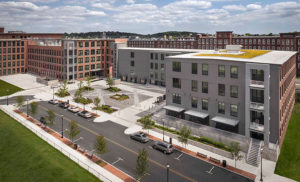
Trinity Financial’s $64 million historic restoration of Lowell's Appleton Mills complex created 130 units of affordable artist housing. Gateway Cities offer opportunities for similar projects in their many downtown Opportunity Zones.
Since the Gateway Cities initiative was launched by the Massachusetts legislature 10 years ago, Trinity Financial has undertaken $300 million worth of development across five of these former industrial communities. Collectively, these projects have yielded 600 units of mixed-income housing and more than 100,000 square feet of commercial space.
In downtown Lowell, we repurposed two historic mill buildings into loft-style apartments geared towards artists and created a home for the UMass Lowell Innovation Hub, which includes a biotech business incubator, a “smart fabric” design facility, and a coworking space. Our mixed-use Enterprise Block project, adjacent to the Brockton commuter rail station, has anchored and catalyzed new investment in the city’s historic downtown. In Lawrence, we are three-quarters of the way through the adaptive reuse of a century-old manufacturing building that will bring 100 units of affordable and workforce housing to the city later this year.
There is one common thread woven throughout our work in Gateway Cities. These projects could not have happened without the investment and support of state-level funding programs, such as MassWorks, the Massachusetts Historic Tax Credit (HTC), the Massachusetts Low-Income Housing Tax Credit (LIHTC), and 40R Smart Growth Districts. These programs have played a workhorse role in encouraging private investment and unlocking the value of the commonwealth’s 26 Gateway Cities.
Half of Zones Are in Gateway Cities
When the Tax Cut and Jobs Act was passed in late 2017, the Federal Opportunity Zone (OZ) program was hailed as one of the most promising new financing tools for urban revitalization and community redevelopment since the Tax Reform Act of 1986 established the federal LIHTC program. OZs offer investors two key tax benefits: deferral of capital gains that are brought into an OZ project, and an exemption from paying any capital gains on the increased value of the OZ asset if the investor keeps their money in the deal for at least 10 years.
Half of the commonwealth’s OZs are located in Gateway Cities, which raised the question: Will OZs be a boon for these post-industrial places? It is still too early to say as investors are still trying to figure out the mechanics of OZ projects. For example, banks – the primary investors in the LIHTCs and HTCs that provide most of the financing for residential and mixed-use projects in Gateway Cities – do not typically have capital gains. At the same time, it is unclear if asset management firms and insurance companies, both of which have significant capital gains, will step in and invest in Gateway Cities. Instead, these investors may gravitate towards projects that are likely to see stronger rent growth and appreciation, such as the Alewife section of Cambridge or the Assembly Row area of Somerville, both of which are designated as OZs.

Dan Drazen
It is unlikely that the OZ program will be a panacea for distressed urban communities, but we welcome the addition of another financing mechanism to bridge what is all too often a gap between funding sources and development costs for projects in Gateway Cities. As the market for OZ deals matures, there may still be a way to leverage OZ investments for the benefit of Gateway Cities that we have yet to understand.
With three more Gateway City projects representing a value of $150 million in our pipeline, Trinity Financial remains committed to the revitalization of these urban communities. With or without the additional financial benefit of OZs, we continue to see development projects in Gateway Cities as a sound investment.
Dan Drazen is a vice president of development at Trinity Financial Inc.




 |
| 
